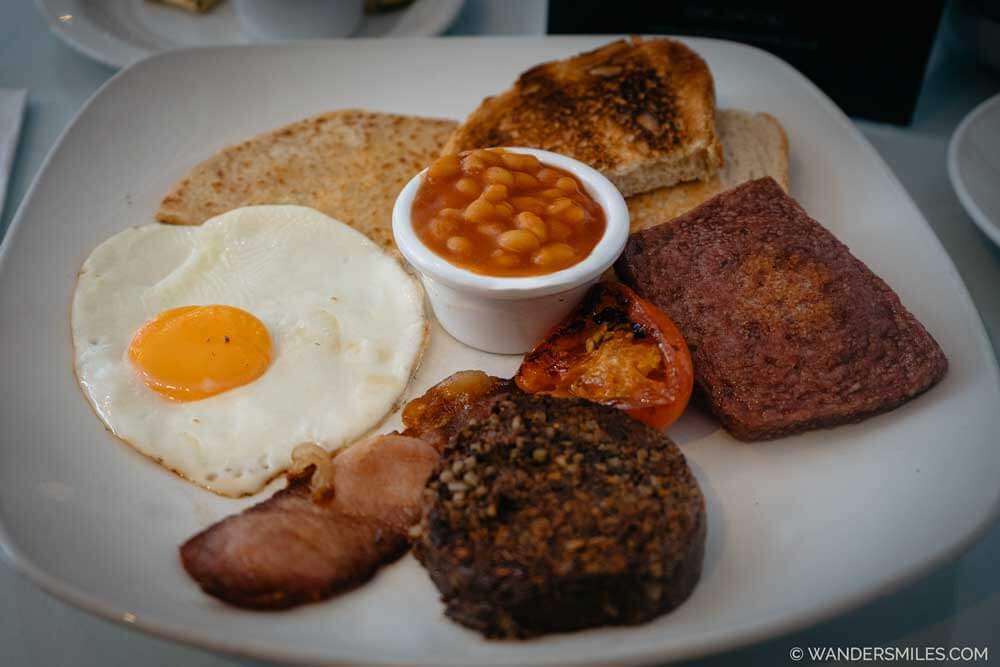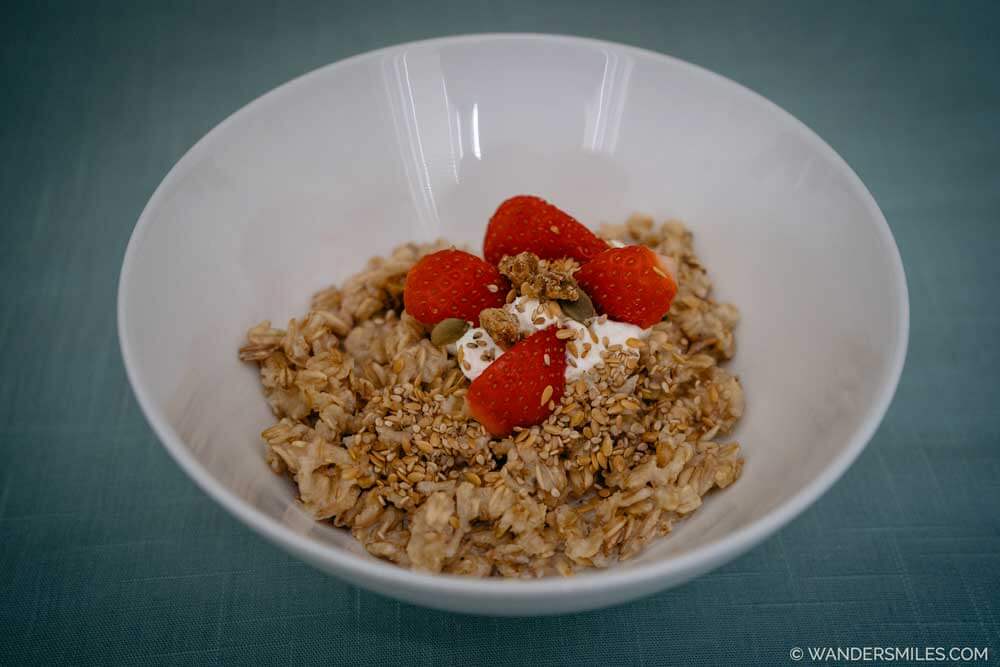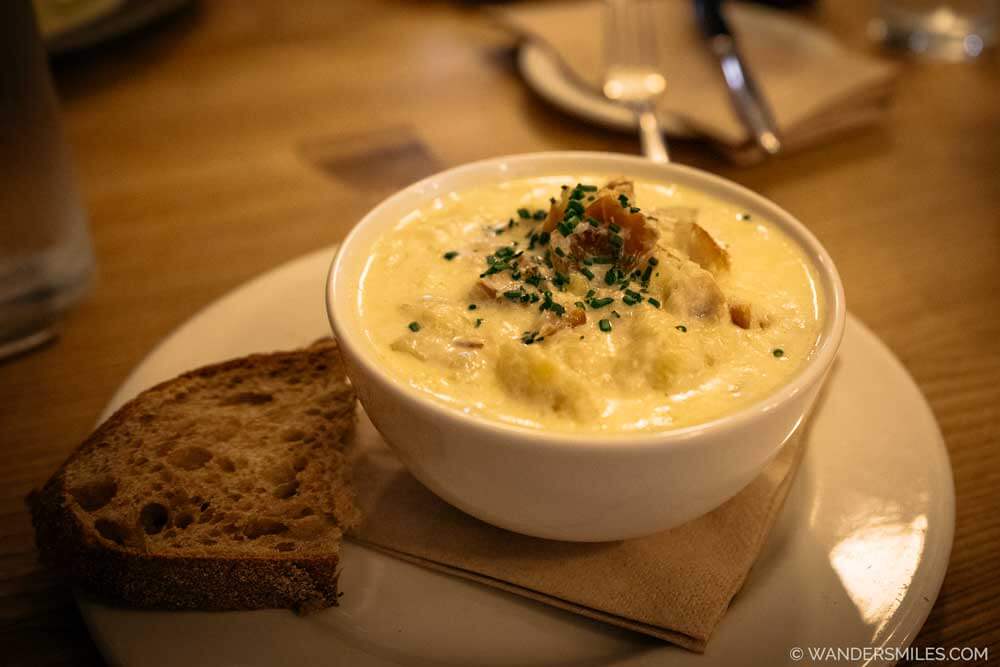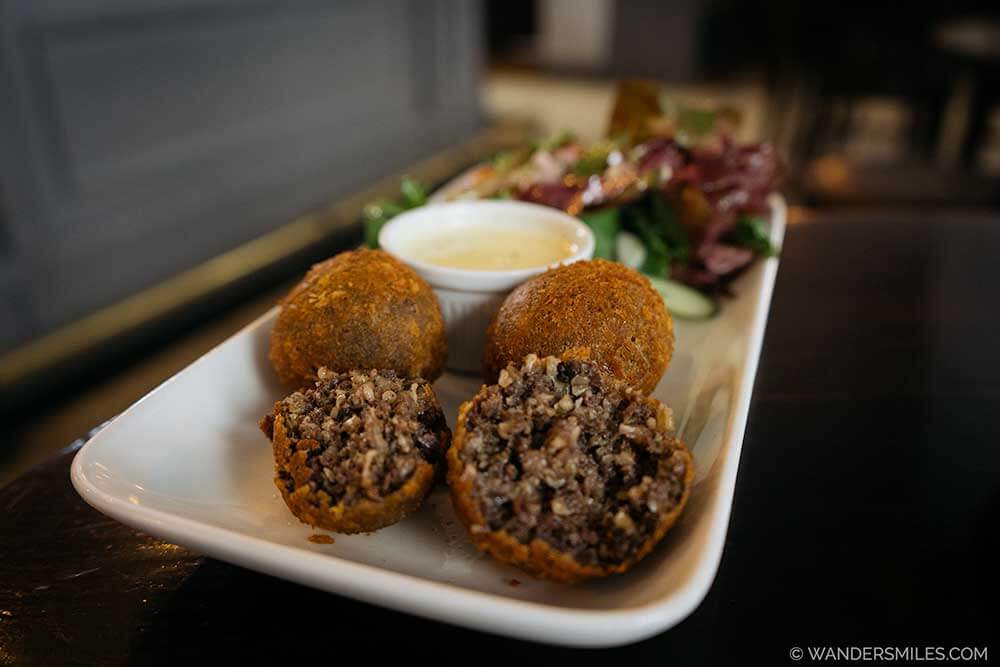
Scotland summons visitors with its untamed landscapes, rugged coastlines, and windswept highlands. The expansive terrain, characterised by increasingly harsh weather as you head north, nurtures resilient farmers, croft owners raising cattle, and fishermen harvesting the day’s freshest catch.
Traditional Scottish food scene thrives on a knack for transforming natural bounty from land and sea into memorable dishes. From hearty stews to comforting breakfasts, and from crumbly haggis to buttery shortbread, Scottish recipes embody culture and creativity.
If you’re planning a trip to Scotland, this guide to must-try Scottish dishes explores the flavours and stories behind these culinary creations. Scottish cuisine celebrates the local ingredients and cooking methods that define Scotland’s simple yet sustainable gastronomy. Now it’s time to start tasting!
Scottish Breakfast
Scottish Breakfast
A traditional Scottish breakfast is not for the faint hearted. It typically includes bacon, sausages, haggis, black pudding, eggs, baked beans, tomatoes, mushrooms, and tattie scones (potato scones), and sometimes, a pile of toast if you’re not fit to burst already.
The main differences from an English breakfast are the addition of some quintessentially Scottish elements: haggis, Lorne sausage, and tattie scones. Haggis is iconic, and while tattie scones are available in England, they’re not standard on the breakfast plate.
So, what is Lorne sausage? It is made from minced meat (usually beef or pork), rusk, and spices, then shaped into a loaf and sliced into squares or rectangles. This unique shape makes it perfect for fitting into a sandwich or a breakfast roll.
The exact history of the Lorne sausage is debated. Some theories suggest it was named after the ancient district of Lorne, now part of Argyll and Bute, or possibly Tommy Lorne, a butcher in the Firth of Lorne. Despite the ambiguity, Lorne sausage, often referred to as ‘square sausage’ or ‘flat sausage’, remains a must-have part of Scottish breakfasts designed to fuel a busy day.

 Traditional Scottish Breakfast
Traditional Scottish Breakfast
Scottish Porridge
Scottish porridge is a hearty breakfast staple made from oats cooked with water or milk until creamy. Topped with honey, berries, seeds, or a sprinkle of salt, it offers a comforting start to the day, it is known for its nourishing qualities and ability to keep one full and energised. Porridge is an excellent breakfast choice before heading on your outdoor adventures in Scotland.
Oats, originally brought to Scotland by the Romans to feed horses, thrived in the country’s favourable conditions: long daylight hours, abundant rainfall, and acidic soil. Alongside barley, oats became one of the few grains that could prosper in the challenging Highland environment.

 Scottish Porridge
Scottish Porridge
Scottish Dishes
Cullen Skink
Cullen Skink is a traditional Scottish soup created in the town of Cullen in Moray. The term “skink”, from the Gaelic word for “essence,” originated as a beef broth but evolved into a smoked haddock soup in the 1890s due to hard times.
This hearty dish features undyed smoked haddock as its primary ingredient, along with potatoes, onions, and milk or cream for a rich consistency. Seasoned with salt, pepper, and sometimes bay leaves or parsley, it’s similar to the creamy fish chowder that started on the Atlantic coast of France and was taken on by Newfoundland and Ireland.
To celebrate this much-loved part of Scotland’s culinary heritage, the Cullen Skink World Championships are held annually in Cullen. If you love it that much, you can taste traditional Scottish food to your heart’s content!

 Cullen Skink: Popular Scottish Soup
Cullen Skink: Popular Scottish Soup
Haggis
Haggis is Scotland’s national dish, however it’s origins are shrouded in mystery. Many believe it has Viking connections, and some trace it back to 13th century France when they had an alliance with Scotland. The earliest written reference to a sausage resembling haggis comes from the Greek playwright Aristophanes, who mentioned it in 423 BC. Either way, Scotland has proudly taken haggis on as their own, and has become a symbol of Scottish culinary culture.
So what is haggis actually made of? It consists of sheep’s offal (heart, liver, lungs) mixed with onions, oatmeal, suet, and spices, all encased in the animal’s stomach and boiled. The dish was created out of necessity ensuring all parts of the animal were used, mixed with readily available ingredients and preserved through traditional cooking methods.
This savoury pudding is famously celebrated on Burns Night, honouring the poet Robert Burns, who wrote “Address to a Haggis” in 1787. Today, haggis is popular all year-round so if you visit Scotland, you can expect to find it on the breakfast buffet, and offered in some capacity in restaurants. Whether it be served with “neeps and tatties” (turnips and potatoes) as a main course, or as a starter as ‘Haggis Bon Bons’ rolled in breadcrumbs deep-fried with whisky cream on the side, it is undoubtedly a tasty traditional Scottish food.
Some Scottish eateries have created vegetarian and vegan haggis alternatives, try Glasvegan in Glasgow, and The Haggis Box or Hendersons, both in Edinburgh.

 Breaded Haggis Bon Bons
Breaded Haggis Bon Bons
Stovies
Stovies can only be described a classic Scottish comfort food. The stew is made from potatoes, onions, and meat, traditionally beef or lamb, slow-cooked together until soft and oozing with flavour.
Like many filling dishes, Scottish Stovies are traditionally the leftovers of a roast dinner, quite literally, the “scrapings off the stove”. Often enjoyed with oatcakes or crusty bread, stovies personify the resourceful spirit of Scottish home cooking.

 Stovies: Traditional Scottish stew
Stovies: Traditional Scottish stew
West Coast Scallops
West Coast scallops are succulent shellfish famous for their sweet, delicate flavour. Found off Scotland’s rugged west coast, particularly around the Hebrides and Isle of Skye, they are sustainably harvested by local fishermen. These scallops have been a culinary tradition for generations, enjoyed fresh or pan-seared with butter and herbs.

 Hebridean Scallops
Hebridean Scallops
Scottish Salmon
Sourced from the cold, clean waters around Scotland’s coast, particularly the Highlands and Islands like Orkney and Shetland, Scottish salmon is known for its sustainable farming practices and high nutritional content, rich in omega-3 fatty acids.
Scottish salmon fishing has a history dating back thousands of years, with evidence suggesting early inhabitants relied on rivers abundant with salmon as a vital food source since around 8,000 BCE.
Scottish salmon is a sought-after delicacy making it a cornerstone of Scotland’s culinary exports. It’s enjoyed grilled, smoked, or in dishes ranging from salads to gourmet meals, and is a firm favourite among seafood enthusiasts.

 Scottish smoked salmon
Scottish smoked salmon
Scotch Egg
A Scotch egg is a tasty snack consisting of a hard or soft-boiled egg wrapped in seasoned sausage meat, coated in breadcrumbs, and deep-fried or baked until golden.
Despite its name, the Scotch egg’s history is traced to 18th-century England, attributed to the Fortnum & Mason department store in London. Its name likely derives from “scotched,” meaning minced meat or beaten, rather than its Scottish origin.
During my Glasgow Food Tour, I had the pleasure of tasting a Stornoway Black Pudding Scotch Egg, adding a Scottish twist to this culinary treasure—and it was undeniably delicious.

 Scotch Egg with Stornoway Black Pudding
Scotch Egg with Stornoway Black Pudding
|| You May Like To Read About Foods of Cumbria
Scottish Desserts & Snacks
Scottish Tablet
Scottish Tablet is a deliciously sweet confection that’s made from sugar, condensed milk, and butter. The flavour is similar to fudge, however it has a more firmer and crumbly texture. The exact origin of Scotland’s melt-in-the-mouth tablet is unknown, but it was first noted in The Household Book of Lady Grisell Baillie in the early 18th century.
It’s easy to make, with the ingredients boiled and then cooled to set. If you want to go fancy, you can add vanilla, whisky or nuts. The Scottish Tablet is a classic after-dinner treat that often wraps up special meals at Scottish weddings and events. Let’s be honest, it’s perfect for anyone with a sweet tooth!

 Scottish Tablet
Scottish Tablet
Clootie Dumpling
Clootie dumplings are a traditional Scottish dessert, named after the “cloot,” or cloth, used to boil them. This spiced pudding, often referred to as Christmas pudding or plum pudding, dates back to the 17th century. It was a common practice to hide coins or charms within the pudding as a way to bestow good luck upon the finder, though there was always the hope that the fortunate individual wouldn’t break a tooth in the process!
The key ingredients of clootie dumplings include flour, breadcrumbs, suet, dried fruits, sugar, spices, and milk, often mixed with treacle or golden syrup. The mixture is wrapped in a cloth, boiled, and then dried, resulting in a dense, fruity pudding traditionally served during festive occasions.

 Clootie Dumpling and Custard
Clootie Dumpling and Custard
Scottish Shortbread
Scottish shortbread is a simple, buttery treat that dates back to medieval times, originally evolving from a biscuit-style bread made from leftover dough. By the 16th century, it had become a refined, buttery treat, popularised by Mary, Queen of Scots.
Traditionally, shortbread was baked for special occasions like Christmas and Hogmanay. The new year custom of shortbread comes from pagan Yule Cakes, and it is still offered to the first person to enter the home of a household on New Year’s Day.
Its simple yet rich recipe of flour, sugar, and butter has remained largely unchanged. Whether enjoyed with a cup of tea or given as a gift, Scottish shortbread is a timeless classic.

 Scottish Shortbread
Scottish Shortbread
Scottish Oatcakes
Scottish oatcakes are wholesome biscuits made primarily from oats, flour, butter, and sometimes a pinch of salt resulting in a rustic texture and nutty flavour.
Favoured for their long shelf life and nourishing qualities, Scottish oatcakes can be enjoyed at breakfast with jam or as a snack. Robert Burns confirms the joys of pairing with oatcakes when he penned “Oatcakes are a delicate relish when eaten warm with ale” in the 18th century.
In the true spirit of Burns, during our whisky tour of Lochranza Distillery on the Isle of Arran, we tasted the Single Malt and creamy Arran Gold while pairing oatcakes with local cheese and smoked salmon. The combination of flavours balanced and complemented each other perfectly.

 Scottish Oatcakes
Scottish Oatcakes
Tunnock’s Teacakes
Tunnock’s Teacakes are iconic Scottish treats consisting of a fluffy marshmallow dome atop a biscuit base, coated in milk chocolate. Introduced in 1956 by Tunnock’s, a renowned Scottish bakery located in Uddingston, they quickly became a national favourite.
Originally marketed as a lighter alternative to cakes, Tunnock’s Teacakes are now cherished for their nostalgic appeal and continue to be enjoyed across the UK and beyond. I defy anyone to say they are not partial to a Tunnock’s Teacake!
Irn-Bru
Irn-Bru is Scotland’s treasured bright orange soda, famous for its unique flavour that blends citrus and hints of spices. Created in 1901 by A.G. Barr in Glasgow, Irn Bru quickly became Scotland’s other national drink beside whisky.
Found throughout Scotland, Irn-Bru holds a special place in local culture, and it’s popularity at gatherings and sporting events is unwavering. Most of all, it is considered a remedy for the occasional (or not) hangover. I was struck by how similar the taste of Inca Kola in Peru was, and considering it’s also their nation’s beloved fizzy drink.

 Cans of Irn Bru
Cans of Irn Bru
Best Traditional Scottish Food Tours
The best way to experience typical Scottish foods is by experiencing the divine restaurants and tasty eateries, To get the lowdown from a local, check out food tours on your travels. I’ve included options for Edinburgh and Glasgow as most travellers will make a stop at one, or both of these wonderful cities.
Best Food Tours In Edinburgh
Best Food Tours In Glasgow
PIN to read about Traditional Scottish Food
Disclosure: This post contains affiliate links, which means I may receive a small commission if you click a link and purchase something that I’ve recommended. It comes at no cost to you. Thank you for your support.
Please visit:
Our Sponsor
